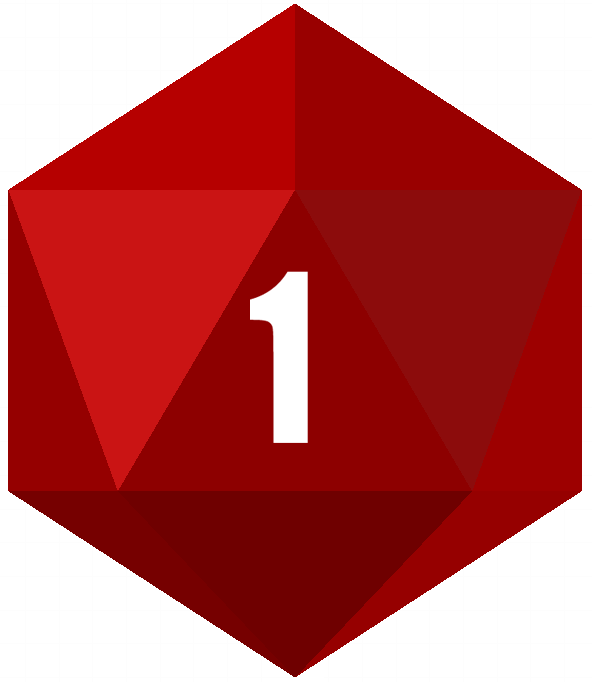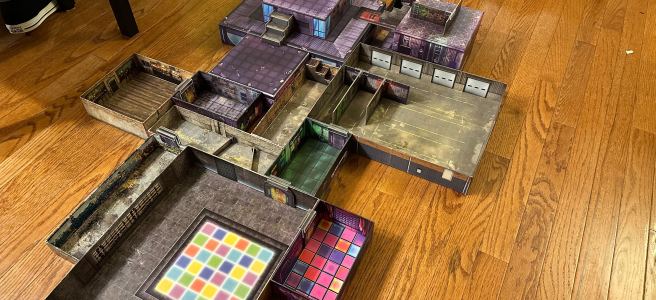As it turns out, boxes are everywhere. Let’s use the power of boxes for gaming – and storage!

But First, an Update
I’ve never been the most prolific blogger but seeing as my last post was August ’23… oof. TLDR new job, no time.
White Line Nightmare continues to simmer, but has blended quite a bit with the more beat ’em up concepts from my Street Lethal idea. The rules are fairly stable, all the changes involve trying to make “what do you do?” more satisfying.
IRL gaming has been mostly Pathfinder 2 with a recent foray back into Savage Worlds superheroes. I’ve been in player mode for a while and am feeling the GM itch once again. Mostly though, I’ve been obsessed with making terrain out of trash. Let’s get to it.
A Sponsored Segment I Actually Noticed
The inspiration behind this recent rabbit hole comes from two places. I saw a sponsor segment from Tenfold Dungeon on some youtube crafting video, and the idea of gaming terrain that nested together for storage was genius. I also realized I’d seen this concept used in a family-favorite boardgame, Ice Cool.
I saw this and instead of simply buying a set, what I clearly needed to do was reverse-engineer their dimensions and make my own modern crime alley set full of places you could have a cool shootout or fistfight. It would be easy (it wouldn’t) and cheaper (it wouldn’t)!
Making the Tenfold Dungeon We Have At Home
The official Tenfold Dungeon dimensions are listed on the packaging and there were some unboxing videos on youtube which helped me understand how it was all designed to fit together. I used Blender to mock up some quick plans for nesting my own boxes and test if different wall thicknesses required changing the overall box sizes.
Why It Wasn’t Easy
The bulk of the work was compositing image textures in Affinity Photo. After a few boxes, I built up enough of a library of sorts that it sped this process along from a snail’s pace to a racing tortoise. Several boxes were larger than letter size paper, which required a lot of trial and error to figure out the best way to overlap the printed textures on the boxes. Furthermore, I’m more of a “measure fast and loose and rely on undo” kind of guy – I had to get comfortable with the age-old adage “measure twice cut once”.
Why It Wasn’t Cheaper
I started this project using matboard for the boxes with double layered walls for extra rigidity. While matboard is sturdy and cuts nicely across the X or Y dimension, it wasn’t the cheapest option, especially compared to what I switched to halfway through. USPS flat rate boxes are free as long as you don’t actually ship anything in them. If you’re going to follow in my footsteps, I’d start there.
The second reason this project has not been the cost saver I thought it might be is that I’m lazy. To cover the boxes, I opted for printable matte sticker paper. While this works great and is dead simple, I needed a lot of it, especially for the larger boxes that required overlapping pieces. Regular paper and spray adhesive probably would have been almost as easy and nowhere near the cost.
The Results
These terrain boxes – either homemade or official Tenfold Dungeon sets – work okay on their own but really shine when combined with scatter terrain. Bonus – you can store your terrain inside the boxes.










I still have a few boxes left to go if I’m going to have a “complete” set equal to the official ones, but even now I can make a setpiece that’s probably larger than most ttrpg scenes or skirmish games would need.
Keep making things out of trash. Also, set your boundaries and don’t feel guilty about sticking to them.

